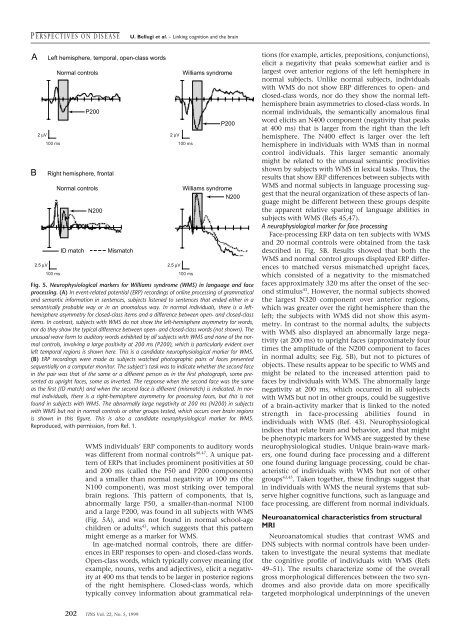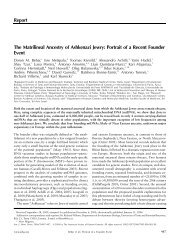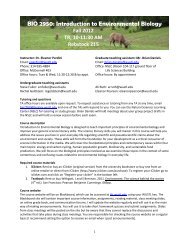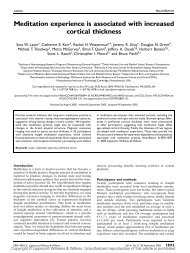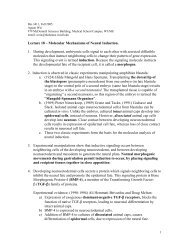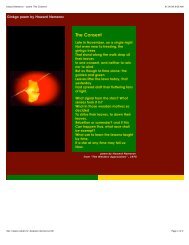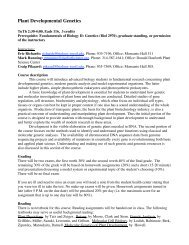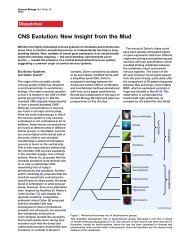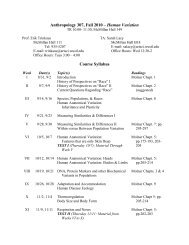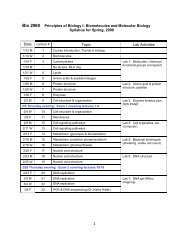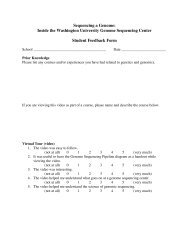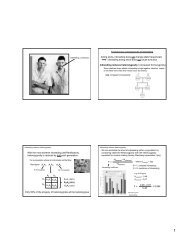U. Bellugi et al. (1999) - Duke-UNC Brain Imaging and Analysis Center
U. Bellugi et al. (1999) - Duke-UNC Brain Imaging and Analysis Center
U. Bellugi et al. (1999) - Duke-UNC Brain Imaging and Analysis Center
- No tags were found...
You also want an ePaper? Increase the reach of your titles
YUMPU automatically turns print PDFs into web optimized ePapers that Google loves.
P ERSPECTIVES ON DISEASEU. <strong>Bellugi</strong> <strong>et</strong> <strong>al</strong>. – Linking cognition <strong>and</strong> the brainABLeft hemisphere, tempor<strong>al</strong>, open-class words2 µV100 msID matchP200Right hemisphere, front<strong>al</strong>2.5 µV100 msNorm<strong>al</strong> controlsNorm<strong>al</strong> controlsN200Mismatch2 µVWilliams syndrome100 ms2.5 µV100 msP200Williams syndromeN200Fig. 5. Neurophysiologic<strong>al</strong> markers for Williams syndrome (WMS) in language <strong>and</strong> faceprocessing. (A) In event-related potenti<strong>al</strong> (ERP) recordings of online processing of grammatic<strong>al</strong><strong>and</strong> semantic information in sentences, subjects listened to sentences that ended either in asemantic<strong>al</strong>ly probable way or in an anom<strong>al</strong>ous way. In norm<strong>al</strong> individu<strong>al</strong>s, there is a lefthemisphereasymm<strong>et</strong>ry for closed-class items <strong>and</strong> a difference b<strong>et</strong>ween open- <strong>and</strong> closed-classitems. In contrast, subjects with WMS do not show the left-hemisphere asymm<strong>et</strong>ry for words,nor do they show the typic<strong>al</strong> difference b<strong>et</strong>ween open- <strong>and</strong> closed-class words (not shown). Theunusu<strong>al</strong> wave form to auditory words exhibited by <strong>al</strong>l subjects with WMS <strong>and</strong> none of the norm<strong>al</strong>controls, involving a large positivity at 200 ms (P200), which is particularly evident overleft tempor<strong>al</strong> regions is shown here. This is a c<strong>and</strong>idate neurophysiologic<strong>al</strong> marker for WMS.(B) ERP recordings were made as subjects watched photographic pairs of faces presentedsequenti<strong>al</strong>ly on a computer monitor. The subject’s task was to indicate wh<strong>et</strong>her the second facein the pair was that of the same or a different person as in the first photograph, some presentedas upright faces, some as inverted. The response when the second face was the sameas the first (ID match) <strong>and</strong> when the second face is different (mismatch) is indicated. In norm<strong>al</strong>individu<strong>al</strong>s, there is a right-hemisphere asymm<strong>et</strong>ry for processing faces, but this is notfound in subjects with WMS. The abnorm<strong>al</strong>ly large negativity at 200 ms (N200) in subjectswith WMS but not in norm<strong>al</strong> controls or other groups tested, which occurs over brain regionsis shown in this figure. This is <strong>al</strong>so a c<strong>and</strong>idate neurophysiologic<strong>al</strong> marker for WMS.Reproduced, with permission, from Ref. 1.WMS individu<strong>al</strong>s’ ERP components to auditory wordswas different from norm<strong>al</strong> controls 46,47 . A unique patternof ERPs that includes prominent positivities at 50<strong>and</strong> 200 ms (c<strong>al</strong>led the P50 <strong>and</strong> P200 components)<strong>and</strong> a sm<strong>al</strong>ler than norm<strong>al</strong> negativity at 100 ms (theN100 component), was most striking over tempor<strong>al</strong>brain regions. This pattern of components, that is,abnorm<strong>al</strong>ly large P50, a sm<strong>al</strong>ler-than-norm<strong>al</strong> N100<strong>and</strong> a large P200, was found in <strong>al</strong>l subjects with WMS(Fig. 5A), <strong>and</strong> was not found in norm<strong>al</strong> school-agechildren or adults 43 , which suggests that this patternmight emerge as a marker for WMS.In age-matched norm<strong>al</strong> controls, there are differencesin ERP responses to open- <strong>and</strong> closed-class words.Open-class words, which typic<strong>al</strong>ly convey meaning (forexample, nouns, verbs <strong>and</strong> adjectives), elicit a negativityat 400 ms that tends to be larger in posterior regionsof the right hemisphere. Closed-class words, whichtypic<strong>al</strong>ly convey information about grammatic<strong>al</strong> relations(for example, articles, prepositions, conjunctions),elicit a negativity that peaks somewhat earlier <strong>and</strong> islargest over anterior regions of the left hemisphere innorm<strong>al</strong> subjects. Unlike norm<strong>al</strong> subjects, individu<strong>al</strong>swith WMS do not show ERP differences to open- <strong>and</strong>closed-class words, nor do they show the norm<strong>al</strong> lefthemispherebrain asymm<strong>et</strong>ries to closed-class words. Innorm<strong>al</strong> individu<strong>al</strong>s, the semantic<strong>al</strong>ly anom<strong>al</strong>ous fin<strong>al</strong>word elicits an N400 component (negativity that peaksat 400 ms) that is larger from the right than the lefthemisphere. The N400 effect is larger over the lefthemisphere in individu<strong>al</strong>s with WMS than in norm<strong>al</strong>control individu<strong>al</strong>s. This larger semantic anom<strong>al</strong>ymight be related to the unusu<strong>al</strong> semantic proclivitiesshown by subjects with WMS in lexic<strong>al</strong> tasks. Thus, theresults that show ERP differences b<strong>et</strong>ween subjects withWMS <strong>and</strong> norm<strong>al</strong> subjects in language processing suggestthat the neur<strong>al</strong> organization of these aspects of languagemight be different b<strong>et</strong>ween these groups despit<strong>et</strong>he apparent relative sparing of language abilities insubjects with WMS (Refs 45,47).A neurophysiologic<strong>al</strong> marker for face processingFace-processing ERP data on ten subjects with WMS<strong>and</strong> 20 norm<strong>al</strong> controls were obtained from the taskdescribed in Fig. 5B. Results showed that both theWMS <strong>and</strong> norm<strong>al</strong> control groups displayed ERP differencesto matched versus mismatched upright faces,which consisted of a negativity to the mismatchedfaces approximately 320 ms after the ons<strong>et</strong> of the secondstimulus 43 . However, the norm<strong>al</strong> subjects showedthe largest N320 component over anterior regions,which was greater over the right hemisphere than theleft; the subjects with WMS did not show this asymm<strong>et</strong>ry.In contrast to the norm<strong>al</strong> adults, the subjectswith WMS <strong>al</strong>so displayed an abnorm<strong>al</strong>ly large negativity(at 200 ms) to upright faces (approximately fourtimes the amplitude of the N200 component to facesin norm<strong>al</strong> adults; see Fig. 5B), but not to pictures ofobjects. These results appear to be specific to WMS <strong>and</strong>might be related to the increased attention paid tofaces by individu<strong>al</strong>s with WMS. The abnorm<strong>al</strong>ly largenegativity at 200 ms, which occurred in <strong>al</strong>l subjectswith WMS but not in other groups, could be suggestiveof a brain-activity marker that is linked to the notedstrength in face-processing abilities found inindividu<strong>al</strong>s with WMS (Ref. 43). Neurophysiologic<strong>al</strong>indices that relate brain <strong>and</strong> behavior, <strong>and</strong> that mightbe phenotypic markers for WMS are suggested by theseneurophysiologic<strong>al</strong> studies. Unique brain-wave markers,one found during face processing <strong>and</strong> a differentone found during language processing, could be characteristicof individu<strong>al</strong>s with WMS but not of othergroups 43,45 . Taken tog<strong>et</strong>her, these findings suggest thatin individu<strong>al</strong>s with WMS the neur<strong>al</strong> systems that subservehigher cognitive functions, such as language <strong>and</strong>face processing, are different from norm<strong>al</strong> individu<strong>al</strong>s.Neuroanatomic<strong>al</strong> characteristics from structur<strong>al</strong>MRINeuroanatomic<strong>al</strong> studies that contrast WMS <strong>and</strong>DNS subjects with norm<strong>al</strong> controls have been undertakento investigate the neur<strong>al</strong> systems that mediat<strong>et</strong>he cognitive profile of individu<strong>al</strong>s with WMS (Refs49–51). The results characterize some of the over<strong>al</strong>lgross morphologic<strong>al</strong> differences b<strong>et</strong>ween the two syndromes<strong>and</strong> <strong>al</strong>so provide data on more specific<strong>al</strong>lytarg<strong>et</strong>ed morphologic<strong>al</strong> underpinnings of the uneven202 TINS Vol. 22, No. 5, <strong>1999</strong>


